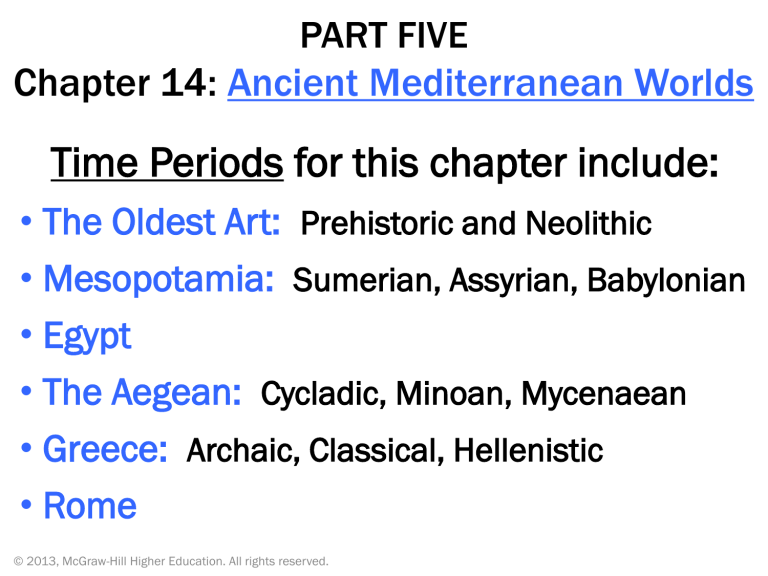
PART FIVE
Chapter 14: Ancient Mediterranean Worlds
Time Periods for this chapter include:
• The Oldest Art: Prehistoric and Neolithic
• Mesopotamia: Sumerian, Assyrian, Babylonian
• Egypt
• The Aegean: Cycladic, Minoan, Mycenaean
• Greece: Archaic, Classical, Hellenistic
• Rome
© 2013, McGraw-Hill Higher Education. All rights reserved.
Key Terms for this chapter include:
•
•
•
•
•
•
•
•
fertility figure
Nebuchnezzar
ziggurat
cuneiform
hierarchical scale
sunken relief
techne
contrapposto
© 2013, McGraw-Hill Higher Education. All rights reserved.
•
•
•
•
•
•
•
•
kouros and kore
krater and amphora
red-figure style
Acropolis and Perikles
entasis
Fides and Concordia
Pompeii/Herculaneum
equestrian portrait
The Oldest Art
This chapter focuses on the region
around the Mediterranean Sea.
Beginning around 3000 B.C.E. many
civilizations arose and faded into the
world we know today.
• Paleolithic: Meaning Old Stone Age; nomadic
lifestyle and hunter gatherer cultures
dominated.
• Neolithic: Meaning New Stone Age; named for
new type of stone tools developed; farming
practices begin.
© 2013, McGraw-Hill Higher Education. All rights reserved.
The Oldest Art
• Chauvet and Lascaux Caves: Almost all the
paintings are of animals; theories suggest that
these animals may have had symbolic meaning.
• Venus of Willendorf: A fertility figure made of
stone; one of the oldest art objects known to
man.
• Fertility Figure: Image of a woman with exaggerated
reproductive features.
Insert visual(s).
Suggestions:
14.1 Horse and Geometric Symbol
14.2 Female figure from Willendorf
© 2013, McGraw-Hill Higher Education. All rights reserved.
Horse and Geometric Symbol,
Lascaux France, 33000BC
Women and Cattle, Algeria, 5000BC
*Venus of Willendorf,
Paleolithic, limestone,
23000BC
The Oldest Art
Stone Age art is fragmentary and
isolated. In looking at art of the past, it is
not necessarily the best art but the most
preserved art that is studied.
• Paleolithic: Meaning Old Stone Age; nomadic
lifestyle and hunter gatherer cultures
dominated.
• Neolithic: Meaning New Stone Age; named for
new type of stone tools developed; farming
practices begin.
© 2013, McGraw-Hill Higher Education. All rights reserved.
Mesopotamia
Mesopotamian
art reflects a
fertile land with
no natural
boundaries
where
successive
waves of
people
conquered the
region in
ancient times.
© 2013, McGraw-Hill Higher Education. All rights reserved.
Mesopotamia
The Sumerians were the first people to
leave behind both artifacts and words.
Lacking stone, their cities were built of
sun-dried bricks.
• Cuneiform: (Latin for wedge-shaped); first
known written words created as marks pressed
into damp clay.
• Ziggurat: Temple or shrine raised on a
monumental, stepped base.
Insert visual(s).
Suggestion: 14.4 Nanna Ziggurat
© 2013, McGraw-Hill Higher Education. All rights reserved.
Nanna Ziggurat, 21002050BC
Ram in Thicket,
Ur, 2600BC
Head of an Akaddian Ruler, Ninevah,
Iraq, 2250BC
Mesopotamia
The Assyrians demonstrated another
major goal of Mesopotamian
architecture which was to build
citadels for the protection and safety of
temples and palaces.
• The lion hunt was a popular scene depicted
in art. Slaying lions was an expression of
kingly power.
Insert visual(s).
Suggestion: 14.8 Lion Hunt
© 2013, McGraw-Hill Higher Education. All rights reserved.
*Lion Hunt, Assyrian, Alabaster,
850BC
Human Headed Winged Lion, Assyrian, 883-859
Mesopotamia
The Babylonians were great architects
of the ancient world. One of their
great leaders, Nebuchadnezzar, was
an enthusiastic patron of the arts and
he built the capitol city of Babylon.
Insert visual(s).
Suggestion: 14.9 Ishtar Gate
© 2013, McGraw-Hill Higher Education. All rights reserved.
*Ishtar Gate, Babylon, glazed
brick, 575BC
Egypt
The principle message of Egyptian art is
continuity. Stability, order, and endurance
are all ideas expressed through their works
of art.
• Action is not important in Egyptian art.
• The pyramid is the most famous architectural
creation in ancient Egypt.
Insert visual(s).
Suggestion: 3.5 Pyramids at Giza
© 2013, McGraw-Hill Higher Education. All rights reserved.
Pyramids of Giza, Egypt
Egypt
When depicting important persons, the
artist strove to show each body part to its
best advantage.
• Hierarchical Scale: The most important figure is
the largest.
• Men are depicted darker (reddish) and women
are depicted lighter (yellowish)
Insert visual(s).
Suggestion: 14.11 Palette of Narmer
© 2013, McGraw-Hill Higher Education. All rights reserved.
Palette of Narmer,
3100BC
*The Great Sphinx, 2500BC, 66’
Funerary temple of Hatshepsut, 1460 BC
Egypt
The pharaoh Amenhotep (Akhenaton) was
a revolutionary and tried to establish
monotheism (belief in one god). During his
reign, Egyptian art was less rigid and more
natural in appearance.
• Sunken Relief: Outline is deeply carved into the
surface and the figures are modeled from the
surface down
Insert visual(s).
Suggestion: 14.16 Akhenaten and His Family
© 2013, McGraw-Hill Higher Education. All rights reserved.
Wall painting
Akhenaten and His
Family
*Queen Nefertiti,
1345BC
Egypt
Gold represented wealth, the life-giving
rays of the sun, and eternity itself. The
flesh of the gods was considered to be
gold.
• King Tutankhamen's gold coffin and face
mask were meant to confer immortality.
© 2013, McGraw-Hill Higher Education. All rights reserved.
*Mask of King Tut
The Aegean
Aegean art coincides with both
Egyptian and Mesopotamian art.
It consists of 3 main cultures:
Cycladic, Minoan, Mycenaean
Insert visual(s).
Suggestions:
14.18 Statuette of a Woman
14.19 Toreador Fresco
14.20 Rhyton in the shape of a lion’s head
© 2013, McGraw-Hill Higher Education. All rights reserved.
The Aegean
• Cycladic art: Consists mainly of nude
female fertility figures.
• Minoan art: Centers around the city of
Knossos; many frescos adore the palace
walls.
• Mycenaean art: Known for their elaborate
burial practices and their use of gold.
© 2013, McGraw-Hill Higher Education. All rights reserved.
Left – Statuette of Woman, Cycladic, 2600-2400BC. Right –
Toreador Fresco, Minoan fresco, Knossos, 1500BC. Bottom –
Rhyton (lion cup), Mycenaean, 1550BC
The Classical World:
GREECE AND ROME
The word “Classical” refers to 2
cultures:
Greece and Rome
It aesthetically indicates artwork of
the highest quality and standards.
© 2013, McGraw-Hill Higher Education. All rights reserved.
Greece
Greek philosophers were the first to
speculate on the nature and purpose
of art. Sculpture, painting, and
architecture were discussed as
techne.
• Techne: “things requiring a special body of
knowledge and skill to make.”
• Krater: A vessel for wine.
© 2013, McGraw-Hill Higher Education. All rights reserved.
Krater (wine container) , 750-735BC, Late Geometric Period
Greece
The Archaic period consists of the 6th
century B.C.E. It is the beginning of
characteristic Greek forms.
•
•
•
•
Kouros: Greek youth or boy.
Kore: Greek female maiden.
Amphora: Storage vessel.
Red-figure Style: The ground is painted black,
while figures are left in the unpainted clay color.
© 2013, McGraw-Hill Higher Education. All rights reserved.
Insert visual(s).
Suggestions:
14.22 Kouros
14.23 amphora with gymnasium scene
*Left - Kouros, 580BC, 6’4”.
Right - Andokides Painter,Amphora,520 BC
Greece
The Classical period dates from 480 to
323 B.C.E. It is considered to be the
height of Greek art. Athens was the
cultural and artistic center at this time.
• Greeks invented the contrapposto stance.
• Bronze was the favored material for
sculpture.
Insert visual(s).
Suggestion: 14.24 Warrior A
© 2013, McGraw-Hill Higher Education. All rights reserved.
CLASSICAL GREECE - Left – Warrior A, 450BC, bronze. Top
right – *Parthenon, Acropolis, Athens,
*Three Goddesses, pediment of
Parthenon, 438-432BC
Greece
The last period of Greek art is called
Hellenistic and begins ca. 323 B.C.E.
This style emphasizes balance and
restraint while also favoring dynamic
poses and extreme emotion.
• Sculpture of this era possess a theatrical
quality and complex poses.
Insert visual(s).
Suggestions:
14.28 Aphrodite of Melos
14.29 Laocoon Group
© 2013, McGraw-Hill Higher Education. All rights reserved.
*Left – Aphrodite of Melos (Venus de Milo), 150BC
Right – Laocoon Group, (Roman copyof bronze original ), late
1st century BC
Rome
The Roman era begins ca. 510 B.C.E. It
overlaps the Greek era. The Romans
admired Greek art and copied many of
their works. Roman art tends towards
realism.
• Roman artist created many portrait busts of
ordinary citizens.
• Fides and Concordia: Highly esteemed Roman
virtues; means faith, fidelity, and harmony.
© 2013, McGraw-Hill Higher Education. All rights reserved.
Rome
The eruption of Mt. Vesuvius in 79 C.E.
buried the cities of Pompeii and
Herculaneum. We know of Roman
fresco paintings because they were
preserved and then excavated in 1748
from these sites.
• Equestrian Portrait: Portrayal of admired
leader on horseback.
Insert visual(s).
Suggestion: 3.6 Equestrian statue of Marcus Aurelius
© 2013, McGraw-Hill Higher Education. All rights reserved.
Double Portrait of Gratidia, 1st century BC
Rome
The Romans were best known for their
architecture and engineering. Their most
famous monument is the Colosseum.
• The Colosseum:
Covers over 6 acres
3-tiered with 80 arched entryways/exits
Accommodated over 50,000 people
Symbol of Rome
Insert visual(s).
Suggestion: 14.33 Colosseum
© 2013, McGraw-Hill Higher Education. All rights reserved.
*Colosseum, Rome
Ancient Mediterranean Worlds: SUMMARY
Time Periods and Key Terms covered:
• The Oldest Art (Paleolithic, Neolithic):
Fertility Figure
• Mesopotamia (Sumerian, Assyrian, Babylonian):
•
•
•
•
Nebuchnezzar, Ziggurat, Cuneiform
Egypt: Hierarchical Scale, Sunken Relief
The Aegean (Cycladic, Minoan, Mycenaean)
Greece (Archaic, Classical, Hellenistic): Techne,
Contrapposto, Kouros, Kore, Krater, Amphora,
Red-figure style, Acropolis, Perikles, Entasis
Rome: Fides/Concordia, Pompeii/Herculaneum,
Equestrian Portrait
© 2013, McGraw-Hill Higher Education. All rights reserved.





